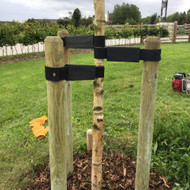How to stabilise a newly planted tree?
Stakes, anchors and guying
We would recommend staking newly planted trees to prevent movement which can damage new roots and prevent the roots from establishing. A newly planted tree can take a couple of years to anchor itself firmly in the soil.
Once your tree can stand unsupported without bending or shifting in the ground you can remove the stakes. This will probably take about eighteen months to three years but may be longer for semi-mature trees or ones or some fruit trees.
How to stake trees
There are a number of different staking methods, depending on the type of tree, tree size and method of planting.
All stakes should penetrate the soil to at least 60cm (2ft) deep. If the stake moves in the ground, it will not anchor and properly support the tree.
Single stake - the common method for staking bare-root trees. The stake should be one-third of the height of the tree. This anchors the roots and allows the stem to sway and thicken
Double stake - the standard method for staking container-grown and rootballed trees. Insert two stakes opposite each other, or equally space three stakes around the tree, they must be outside the root ball. Secure the stakes to the tree trunk using tree ties.
Using tree ties
We would recommend you use a tree tie intended for trees! There is a variety available, from soft rubberised tree ties to tree belting and strapping.
They are made from durable, long-lasting plastic, with buckles for fastening and adjustment. These ties can be loosened as the tree girth expands.
You can also buy spacers that will prevent the stake rubbing against the tree trunk and damaging it. These can be called rubber blocks, rubber tree cushions, spacer sleeves or hoop spacers.
Guying
Guying is ideal for large, transplanted trees that are to be planted in areas exposed to strong winds. Guy-wires are tensioned cables that are designed to add stability. You can buy guying kits for different sized trees that has everything you need and will simplify and reduce the installation time. Kits contain high tensile wire, galvanised anchors, rubber bark protectors, ratchet tensioner and wire joining clips
The three anchors should be evenly spaced evenly around the root ball and driven into the base of the pit approximately 50mm out from the edge of the rootball, The guy wire will then attach to each of these and attach to the tree trunk at no more than 45 degrees and be adjusted using the ratchet tensioner to ensure the trunk is secure.
Tree anchors
Ground anchors are essentially underground staking systems. They are designed to provide much-needed stability and security for newly planted trees. In most cases the tree anchor is secured over the root ball, providing greater contact with the surface area of the rootball and as result improved root support for the newly planted tree. They are discreet and better where visible above-ground methods would be unacceptable. Tree anchors must be fitted at the time of planting. You can buy tree anchoring fixing kits for different sized trees. These have everything you need and will simplify and reduce the installation time.
- After digging the tree pit to the required size, drive the three anchors into the base of the pit, evenly spaced and approximately 50mm out from the edge of the rootball.
- Using the hand drive rod or the petrol post driver. You should then load the anchors with the anchor loading hook or anchor loading jack, ensuring the hard eye is pulled up to sit ¾ up from the bottom of the rootball in a tripod fashion.
- To protect the rootball straps can be laid over the rootball.
- Thread the tensioning wire (which is attached to the ratchet tensioner) through the anchor loops and slot into the Rootball Protector in a tripod fashion.
- The wire should be pulled through the spindle until tight and any excess cut off. Leave approximately 50mm. Winding the ratchet wheel using the ratchet tensioner tool will cause the wire to tension under pressure. Be sure to check that each leg of the wire is centred on the Rootball Protector strips.

